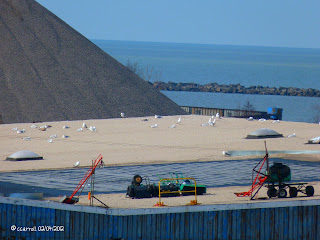Meeting up with my Pennsylvania birding friend, Steve, I took a day trip to Ashtabula, Ohio to try for the Black-tailed Gull (Larus crassirostris) that has been present, but often difficult to see, for several months. Some nice photos of the black-tailed gull have been posted on-line; what I offer here are tiny specks. Steve had already seen the gull a few weeks earlier on a much colder and windier day and was acquainted with the area. The black-tailed gull's Wikipedia page offers some interesting tidbits of information on the bird, including the origin of its Japanese and Korean nicknames, Sea cat and "cat" gull.
A trio from Kentucky were visiting to see the black-tailed gull and they started the search with finding a Glaucous Gull (Larus hyperboreus) on the roof of one of the very industrial Ashtabula harbor buildings that are also favored by the black-tailed gull. The glaucous gull is the white speck at the peak of the roof on the left.
Cropped view of the same bird, above and below, still very tiny. The glaucous gull was either a pale juvenile or a 2nd winter bird.
As nice as seeing the glaucous gull was, it was not the purpose of our visit and we turned our attention to finding the black-tailed gull. The bird did appear, making a couple of brief landings on the corner of another roof, but it never stayed long. It was active flying around the large dirt piles that were heaped along the channels of the harbor. In flight its black tail was nicely seen when it banked around the dirt piles.
A Snowy Owl (Nyctea scandiaca) has also been around this same industrial area for awhile. The birders from Kentucky told us of its location and we took a break from the windy gull viewing to find the owl. It was perched on a brush pile - the white speck in the middle of the photo - in a rail yard with a large pile of coal behind for its back drop.
Above is a cropped view of the snowy owl. Through the spotting scope, of course, this bird was well seen and was essentially an all white bird. This snowy had made the local news so several birders, and non-birders, were present and it was a life bird for most. This was a companionable birding experience and we stayed here for awhile. As the crow flies, the location of the owl was less than 1/4 mile from the black-tailed gull.
Leaving the snowy owl, we drove to another nearby lookout. The town of Ashtabula is old and very industrial. We drove up an original cobblestone road to the Ashtabula Maritime Museum parking lot perched on a bluff overlooking the rail yard and found the snowy owl again. From so high above, waterfowl could be spotted on the harbor channels - mostly Common Mergansers and Canada Geese, but also one juvenile Great Black-backed Gull (Larus marinus).
The sun had come out and we made another pass for the black-tailed gull from the Lake Shore Park overlook that offered the best view of the harbor buildings. This time it was just Steve and me on the overlook and Steve found the bird - again in the same general area as earlier. The sun helped enormously for excellent viewing of the gull through the spotting scope. The bi-colored black and red bill tip showed up nicely.
The photo above shows the whole roof top view. The black-tailed gull is the tiny speck in the middle. Below are three cropped images of the gull.
As far as I could tell, all of the other gulls on these roofs were herring gulls, thus the easily noted size difference. Ring-billed gulls were clumped in the parking lot, beach and picnic area of the park.
Before leaving for lunch, we made a brief stop at the beach and found only the ring-billed gulls. Steve had done some research for lunch and we went to Compadres Mexican Restaurant on West Street for authentic tortilla soup and ceviche.
After lunch we checked on the, by now out-of-sight, snowy owl and took another look for the black-tailed gull. We hoped to find it closer, perhaps even flying over the open water of the park. We learned that we had missed it doing just that.
The city of Ashtabula, Ohio has an interesting history as described in the Wikipedia link attached. In 2000 the population was nearly 21,000. I wonder if it has maintained this population for the 2010 census? The city was quaint, but shabby and tired. It's hard to imagine that Ashtabula would have been able to escape the devastation of our recession over the last several years. I might never visit again but I am happy that I had this chance - thanks to a black-tailed gull.
Final note: On the way home, driving west on the I-480 beltway around Cleveland and at the western edge of the Cleveland airport, an adult Northern Goshawk (Accipiter gentilis) was perched in a hunting pose on a light pole on the north side of the expressway. This was a surprise! I entered the sighting in eBird and, as northern goshawk is an add-on species for the Ohio list, it will be interesting to see if I hear from the Ohio eBird supervisors. I looked back through the Ohio listings to see if a goshawk had been mentioned. As it happens, a possible goshawk was reported on January 30th. However, the bird in question then was an immature bird and, by many but not all, thought to be a Cooper's Hawk (A. cooperii). The I-480 goshawk was clearly an adult bird and there had been no prior reports of adult goshawk.










No comments:
Post a Comment